Water in the form of steam has the ability to store great amounts of energy. With it's ease of control and delivery, steam brought the advent of power to the shipping world. There are still some steam powered vessels such as ULCC ( Ultra Large Crude Carrier ) where steam turbines can provide the necessary, high power shaft requirements to propel the ship. However it's time as passed, most ships nowadays use the more economical diesel burning heavy fuels. Although boilers may no longer be commonplace for ship propulsion they are almost guaranteed to be one boiler for various duties on board a ship. Duties like heating cargo, fuel, and accommodations. Some ships also use boilers for auxiliary power. Such as deck winches and pumps, where electrical machines would prove to be a hazard as in the oil industry. Within the boiler, fuel and air are force into the furnace by the burner. There, it burns to produce heat. From there, the heat (flue gases) travel throughout the boiler. The water absorbs the heat, and eventually absorb enough to change into a gaseous state - steam. To the left is the basic theoretical design of a modern boiler. Boiler makers have developed various designs to squeeze the most energy out of fuel and to maximized its transfer to the water. But it all boils down, pardon the pun, to the basic design shown here. Below are a description of the most accepted variations of the basic principles ( above left ). As you can see, the Babcock Marine Water Tube Boiler (below) looks very complicated. Thousands of tubes are placed in strategic location to optimize the exchange of energy from the heat to the water in the tubes. These types of boilers are most common because of their ability to deliver large quantities of steam. The large tube like structure at the top of the boiler is called the steam drum. You could call it the heart of the boiler. That's where the steam collects before being discharged from the boiler. The hundreds of tube start and eventually end up at the steam drum. Water enters the boiler, preheated, at the top. The hot water naturally circulates through the tubes down to the lower area where it is hot. The water heats up and flows back to the steam drum where the steam collects. Not all the water gets turn to steam, so the process starts again. Water keeps on circulating until it becomes steam. Meanwhile, the control system is taking the temperature of the steam drum, along with numerous other readings, to determine if it should keep the burner burning, or shut it down. As well, sensors control the amount of water entering the boiler, this water is know as feed water. Feed water is not your regular drinking water. It is treated with chemicals to neutralize various minerals in the water, which untreated, would cling to the tubes clogging or worst, rusting them. This would make the boiler expensive to operate because it would not be very efficient. On the fire side of the boiler, carbon deposit resulting from improper combustion or impurities in the fuel can accumulate on the outer surface of the water tube. This creates an insulation which quickly decrease the energy transfer from the heat to the water. To remedy this problem the engineer will carry out soot blowing. At a specified time the engineer uses a long tool and insert it into the fire side of the boiler. This device, which looks like a lance, has a tip at the end which "blows" steam. This blowing action of the steam "scrubs" the outside of the water tubes, cleaning the carbon build up. Water tube boilers can have pressures from 7 bar (one bar = ~15 psi) to as high as 250 bar. The steam temperature's can vary between saturated steam, 100 degrees Celsius steam with particle of water, or be as high as 600 - 650 degrees Celsius, know as superheated steam or dry steam (all water particle have been turn to a gaseous state). The performance of boiler is generally referred to as tons of steam produced in one hour. In water tube boilers that could be as low as 1.5 t/hr to as high as 2500 t/hr. The larger boilers would be land based, your local power company would mo Foster Wheeler (USA/UK), Babcock (USA/UK/Ger), Combustion Engineering (USA), and Kawasaki Heavy Industries (Japan) are some of the more prominent manufacturer of boilers. Click on the picture to the right to view a full size diagram of a Foster Wheeler ESD III water tube boiler. This type of boilers started it all. This is the original design of boiler which brought the tide of power to the marine world. If you are ever in On a modern ship, the fire tube boiler meet the ship's heating needs and is generally not used for deck machinery. The steam produced will circulate through coils in the cargo tanks, fuel tanks, and accommodation heating system. They are generally supplied as a complete package, such as the one pictured above. This is a single furnace, three pass type fire tube boiler. Heat - flue gases - travels through three different sets of tubes. All the tubes are surrounded by water which absorbs the heat. As the water turns to steam, pressure builds up within the boiler, once enough pressure has built up the engineer will open main steam outlet valve slowly, supplying steam for service. Fire tube boilers are also known as "smoke tube" and "donkey boiler". On smaller ships the auxiliary boiler can be a stand alone unit and would most likely be of the fire tube boiler arrangement as described above. But on a larger vessel it is more efficient for the auxiliary boiler to take advantage of the main engine's flue gases to heat the water. Basically this means that the hot gases from the main engine must pass through a heat exchanger (the auxiliary fire tube boiler) before exiting to the atmosphere On this diagram, look for it above, and just aft of the main engine, near the exhaust stake of the ship. It is called the "cargo heating boiler". As you can imagine if the ship's main engine was not running, there would be no hot flue gases to make steam. The auxiliary boiler also has a burner assembly which can be operated while the ship is in port or when the flue gases With this Cochran type boiler, the flow of flue gases from the engine are controlled by a damper. Should the damper not allow engine flue gases through, the burner would automatically come on and provide heat for the water to absorb. It would do so until the controls of the damper allowed the flue gases to flow through the boiler providing the necessary heat for the water, the burner would then shut down. Rotating the propeller is the ultimate goal of any power plant. As you have probably noticed, from the text and pictures above, there is no shaft. Which leads to the question: "now that you have all this super energized steam, how do you get work from it ? " A boilers is only one part of a larger operation, granted, it's a large part but most important part of the operation is it's ability to apply all this steam power. Every action has an equal and opposite reaction. Everything in nature reaches a balance. High pressure steam, 20bar, wants to 'go back' to being like everything else on the planet, which is water at 1 bar. If you understand the above, basic, principle, engines become very logical machines. In the earlier days the primary engine to transform the steam's heat energy to mechanical energy was done using a piston within a sealed housing. Valves in the sealed housing would allow steam to enter into the chamber, the steam restricted by the sealed housing would push on the piston, forcing it down. This downward motion of the piston was transmitted to the crankshaft by a connecting rod. The illustration below is the best way to view the basic principle of the piston action. This illustration, courtesy of Rick Boggs' Merchant Marine and Maritime Pages, is of a Triple Expansion Steam Engine. This type of design was very common at the earlier part of the 20th century. The SS Master, a tugboat on display at the Vancouver Maritime Museum, has a good example of a working Although the model rotates a little fast, it clearly illustrates the action of the steam. The superheated steam (steam @ 101+degrees Celsius) will be used to "push" up or "down" three times in this engine. The first time, where the steam has the most energy, the valve allows it to enter the small cylinder, on the topside of the piston. The expansion (pressure) of the steam pushes down on the area of the piston, rotating the crankshaft. The steam is then release by ports, near the end of it's stroke. The steam is then directed to the following cylinder. Here for a second time, by way of a valve, the steam enters the medium size cylinder and exert it's pressure on the area of the piston forcing it down. Finally, with most of the energy already spent, the steam enters the third and final stage of the engine as it did in the two previous stages. The steam enters the large diameter cylinder, pushes down the piston and exits the engine. The steam is then collected in a vacuum environment called acondenser, where the remaining heat in the steam is dispelled and changes state, back to being water. The water is then fed, or should I say recycled, as feedwater for the boiler. The pistons of this engine are called double acting, which means that, not only does the piston get "pushed down" but it also gets "pushed up". The three stages describe above are also, simultaneously, happening to the underside of the piston. So steam enters the top of the piston, pushes it down, then the valve allows steam to enter the bottom of the piston, pushing it up. The more modern method of extracting mechanical energy from heat energy is the steam turbine. Steam turbine have been the norm in various land based power plants for many years. BC Hydro's Burrard Thermal Plant just outside Vancouver is very similar to many power plants in most countries, and a good example of a steam power plant. The Burrard Generating Station is a 950 MW conventional natural gas-fired generating station. It's large boilers create large amounts of steam which is then fed to steam turbines. The turbines rotate large alternators, which produce electrical energy. On a ship, the operation is generally smaller, even on very large super tankers. On a ship, the turbine is connected to a reduction gear, which drives a propeller, producing motion instead of electrical energy. If you can imagine a pinwheel, held solidly near your mouth, then blowing, at the right angle, air unto each "blade" of the pinwheel. You see the whole pinwheel turn. The principle of the impulse turbine is much the same. The impulse turbine contains several "pinwheels" which are actually called turbine rotors, pictured to the right. The rotors can rotate on a shaft, but cannot slide for and aft. "In front" of these rotors are nozzles, drilled into the stationary part of the turbine. Because steam does not like to be confined, each nozzle ejects steam onto one blade of the rotor, much like we imagined with the "pinwheel". Because the shape of the blades is at an angle, the jet of steam must change direction. This change in direction results in a force, rotating the rotor which rotates the shaft. One set of turbine rotor and stationary nozzles is called a stage. Much like the triple expansion piston type engine, mentioned above, the steam travels through many stages. In the case of steam turbines, the steam proceeds through one stage, then collects and proceeds to the second stage and so on. Each time, the steam proceeds to a larger diameter rotor turbine, until the most of it's energy has been exerted on the rotors of the turbine. The energy depleted steam is drawn, by vacuum, to thecondenser where it is cooled to form feed water, ready to feed the boiler once again. As with any machine, improvements and specific designs have evolved to improve the overall efficiency of the machine. One turbine design is the impulse design as describe above. Another is the reaction type turbine, both types are illustrated below. A third is more of a hybrid design, combining, actually compounding, features from the impulse and reaction type steam turbines. The impulse design (above left) relies on stationary ring of steam nozzles to direct flow onto the blades of a rotor. In the reaction type (above right), the flow of steam must pass through the rotor. The rotor is made up of blades, just like the impulse type, but in this case the blades The blades on the impulse type change the direction of the steam, whilst in the reaction, the blades become the nozzles. The illustration above show the differences between the two types. The images to the right, courtesy of Rick Boggs' Merchant Marine and Maritime Pages, illustrates a reaction type steam turbine. Steam turbines rotate at very high speeds but in order to get the most efficiency from the propeller, the propeller must turn slow. Therefore a marine gear must be used. Marine gears are very common place, they are used to transform power from an engine to the actual machine doing the work, in this case the propeller. Then check the pages below. Spirax Sarco has a great deal of information on steam systems and procedures So who is the "father" of the steam engine? James Watt, read about him here. Want to know allot more about the History of steam turbines, check here. Here is a website for those allready involve in steam systems. Visit an informative page on the skinner engine, a reciprocating steam engine. An interesting site on steam - Steam Esteem from Lars Josefsson Check out uber steam engineer Wayne Kirshner's excellent websiteSteam Plants

Steam Theory
The water tube boiler

 st likely operate one. In British Columbia, large boilers are most common at Pulp and Paper plants.
st likely operate one. In British Columbia, large boilers are most common at Pulp and Paper plants.The fire tube boiler
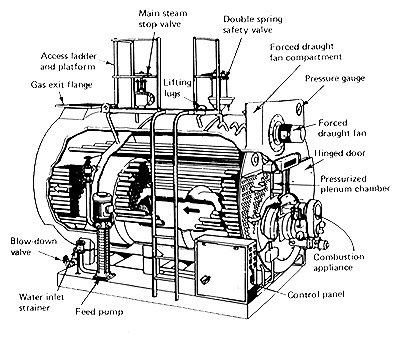 Vancouver, BC, the SS Master, a turn of the century tugboat, is open for the public to view at the Vancouver Maritime Museum. It is operational, and a fine example of ship using a fire tube boiler.
Vancouver, BC, the SS Master, a turn of the century tugboat, is open for the public to view at the Vancouver Maritime Museum. It is operational, and a fine example of ship using a fire tube boiler.. . . and the Auxiliary boiler

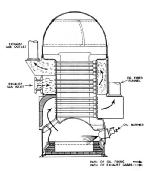 are not hot enough to provide the necessary steam.
are not hot enough to provide the necessary steam.Using the steam to make the ship go !
The reciprocating steam engine.
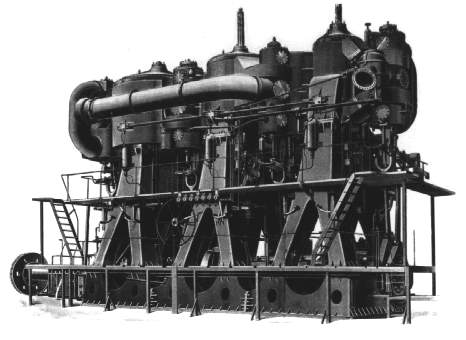
Theory
![]()
![]()
![]()
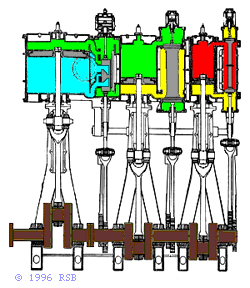 triple expansion steam engine. The Famous RMS Titanic had two similar engines, except the Titanic's had an additional stage. They were known as quadruple expansion engine and operated on the same principle.
triple expansion steam engine. The Famous RMS Titanic had two similar engines, except the Titanic's had an additional stage. They were known as quadruple expansion engine and operated on the same principle.
The Steam Turbine

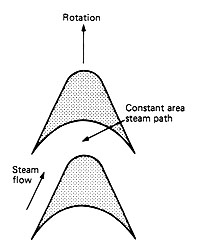
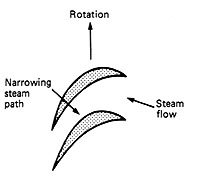
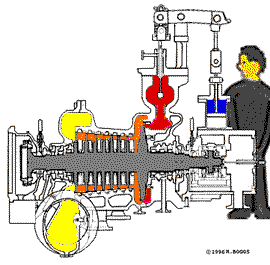 are curved to provide a slight nozzle shape.
are curved to provide a slight nozzle shape.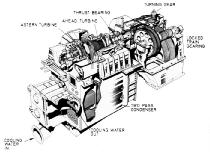 In the picture to the left, the gear is situated behind the turbine. This is a 20,000hp steam turbine package. You can notice the condenser just below the turbine assembly.
In the picture to the left, the gear is situated behind the turbine. This is a 20,000hp steam turbine package. You can notice the condenser just below the turbine assembly.Want more steam ?
Sunday, April 25, 2010
Steam Plants
Posted by A long distance at 2:26 AM
Subscribe to:
Post Comments (Atom)
0 comments:
Post a Comment